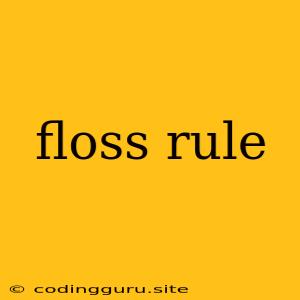The Importance of Flossing: A Rule for a Healthy Smile
Maintaining good oral hygiene is crucial for overall health, and flossing plays a vital role in achieving this. While brushing is essential for removing food debris and plaque from tooth surfaces, flossing is the only way to reach the spaces between your teeth where your toothbrush can't. This is where bacteria and food particles accumulate, leading to various dental problems if left unchecked. So, why is flossing so important and why is it considered a rule for a healthy smile? Let's delve deeper.
What Does Flossing Do?
Flossing helps in the following ways:
- Removes Plaque and Food Particles: The tiny spaces between your teeth can trap food particles and plaque, which are sticky films of bacteria that can lead to cavities and gum disease. Flossing removes this debris, keeping your teeth and gums healthy.
- Prevents Gum Disease: Gum disease, also known as periodontal disease, is an infection of the gums that can cause inflammation, bleeding, and even tooth loss. Flossing helps to prevent gum disease by removing plaque and bacteria from the gum line.
- Freshens Breath: Bacteria in the mouth can cause bad breath, and flossing helps to remove these bacteria, leaving your breath fresh.
- Reduces Risk of Cavities: Flossing removes plaque and food particles that can contribute to the formation of cavities.
- Improves Overall Oral Health: Flossing is an essential part of a comprehensive oral hygiene routine and contributes to maintaining overall oral health.
How Often Should You Floss?
The American Dental Association (ADA) recommends flossing at least once a day, preferably before bedtime. Flossing before bed gives your mouth a chance to clean itself overnight.
How to Floss Properly
Here's a simple guide to flossing correctly:
- Cut a piece of floss about 18 inches long. Wrap the ends around your middle fingers, leaving about two inches of floss in between.
- Gently guide the floss between your teeth, using a sawing motion. Be careful not to snap the floss against your gums, as this can irritate them.
- Curve the floss around each tooth in a "C" shape. This helps to remove plaque and food particles from both sides of the tooth.
- Slide the floss up and down against each tooth, making sure to get under the gum line.
- Use a fresh section of floss for each tooth.
- Repeat the process on the other side of your mouth.
Tips for Flossing:
- Choose the right floss: There are several types of floss available, including waxed, unwaxed, and flavored. Choose the type that is most comfortable for you.
- Use a floss holder: Floss holders can make flossing easier, especially for those with dexterity issues.
- Don't be afraid to ask your dentist for help: If you are struggling to floss properly, your dentist can show you the correct technique.
Flossing: A Rule for a Healthy Smile
Flossing is a vital part of a healthy oral hygiene routine. It helps to prevent plaque and bacteria buildup, reduce the risk of cavities and gum disease, and improve overall oral health. Remember, flossing is a rule for a healthy smile, so make sure to include it in your daily routine.
Disclaimer: This article is intended for informational purposes only and should not be construed as medical advice. Please consult with your dentist or other qualified healthcare provider for any questions you may have regarding your oral health.
